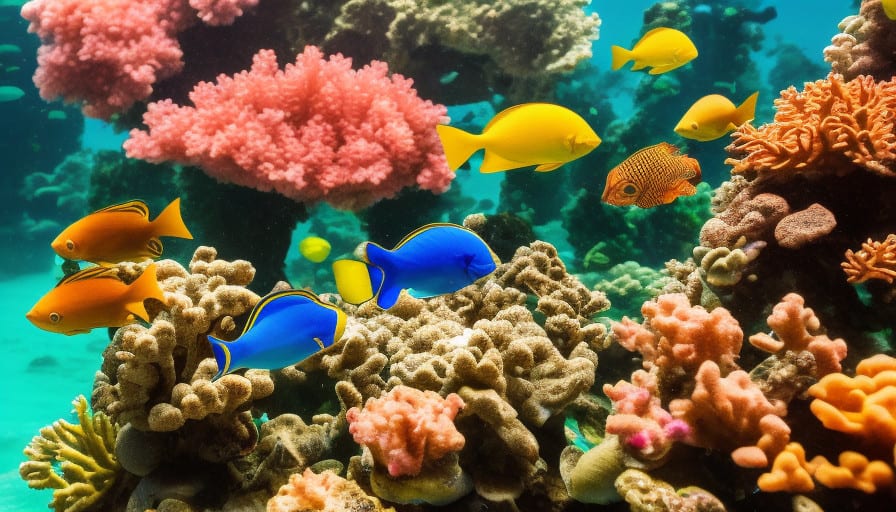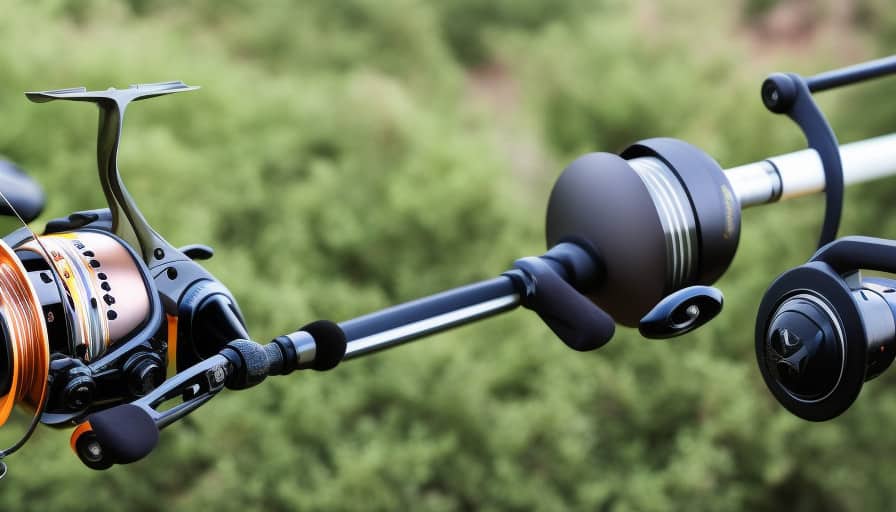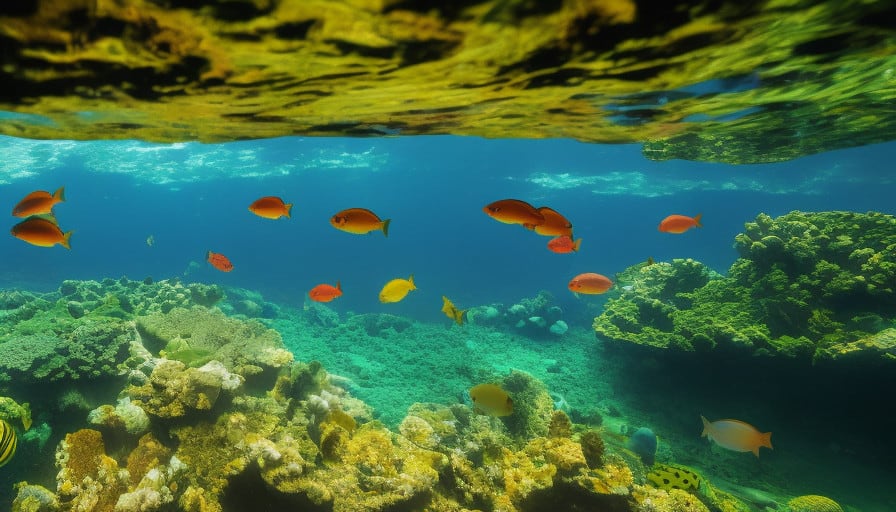In the pursuit of comprehending fish behavior, a crucial step is to adopt the perspective of a fish and perceive the world through their senses. This article delves into the intricate details of the five senses of fish, shedding light on their communication patterns, social behavior, feeding habits, and responses to environmental stimuli.
Furthermore, it explores the complex phenomena of fish reproduction and migration. By adopting an objective and scientific approach, this article aims to provide the audience with a comprehensive understanding of fish behavior, catering to their desire for mastery in this domain.
The Five Senses of Fish
The five senses of fish encompass vision, hearing, smell, taste, and touch, all of which play crucial roles in their behavior and survival. Fish sensory systems have evolved to allow them to navigate their environment, locate food, avoid predators, and communicate with other individuals.
Vision is an important sense for fish, enabling them to detect and interpret visual cues in their surroundings. They have specialized visual adaptations that allow for optimal vision in different aquatic environments.
Hearing is also essential for fish, allowing them to perceive sounds and vibrations in the water, which can indicate the presence of predators or prey.
Smell and taste are closely linked in fish, as they use chemical cues to locate food, identify potential mates, and navigate their environment.
Lastly, touch is important for fish to interact with their surroundings, detect water currents, and communicate with conspecifics.
However, the impact of pollution on fish senses is a growing concern. Pollutants such as heavy metals, pesticides, and pharmaceuticals can interfere with fish sensory systems, impairing their ability to perceive and respond to their environment. This can have detrimental effects on their foraging, reproduction, and survival.
Understanding the sensory capabilities of fish and the potential impacts of pollution on their senses is crucial for effective conservation and management strategies.
Communication and Social Behavior in Fish
Communication among fish is influenced by their social behavior. Fish use various signals and behaviors to communicate with each other, allowing them to coordinate activities, establish territories, and find mates. Understanding fish communication and social interactions is crucial for gaining insight into their behavior and ecological dynamics.
Here are four key aspects of fish communication and social behavior:
-
Visual signals: Many fish species use visual displays to communicate. These signals can include changes in coloration, body postures, and fin movements. For example, male fish may display vibrant colors to attract females or signal aggression to rival males.
-
Acoustic communication: Some fish produce sounds to communicate with each other. These sounds can serve different purposes, such as attracting mates, warning of danger, or establishing territory. For instance, the grunting sounds made by some species of grouper during courtship serve as an acoustic signal to potential mates.
-
Chemical signals: Fish also use chemical signals, known as pheromones, to communicate. Pheromones are released into the water and can convey information about reproductive status, territorial boundaries, and social hierarchy. This chemical communication is particularly important in species that have limited visibility or live in murky environments.
-
Tactile communication: Physical contact and touch can also play a role in fish communication. Fish may engage in behaviors such as nuzzling, fin displays, or rubbing against each other to convey information or establish social bonds.
Understanding the complexities of fish communication and social interactions can provide valuable insights into their behavior, mating strategies, and overall ecological dynamics. Further research in this field will continue to enhance our understanding of fish and their fascinating social lives.
Understanding Fish Feeding Patterns
Feeding patterns in fish can be understood by examining their dietary preferences and foraging strategies. Fish feeding habits vary greatly among species and are influenced by a combination of factors, including their nutritional requirements, habitat availability, and prey abundance. Some fish species are herbivorous, feeding primarily on plants and algae, while others are carnivorous, preying on smaller fish, invertebrates, or even other vertebrates. Omnivorous fish have a broader range of dietary options and can consume both plant and animal matter.
Foraging strategies employed by fish can be categorized into different types, such as ambush predation, active pursuit, filter feeding, and scavenging. Ambush predators, such as pike or largemouth bass, lie in wait for their prey and then rapidly strike. Active pursuit predators, like tuna or marlin, chase down their prey in open water. Filter feeders, such as whale sharks or manta rays, filter small organisms from the water using specialized structures. Scavengers, such as catfish or vultures, feed on dead or decaying organisms.
Understanding fish feeding patterns and foraging strategies is crucial for conservation efforts, as it allows us to assess the impacts of environmental changes on fish populations and ecosystems. It also helps in the development of effective management strategies, such as the establishment of protected areas or the implementation of sustainable fishing practices.
Environmental Factors and Fish Behavior
Environmental factors play a significant role in shaping the behavior of fish species. Fish behavior is influenced by various aspects of their environment, including water quality and habitat preferences. Understanding how these factors affect fish behavior is crucial in managing and conserving fish populations.
Here are four key environmental factors that influence fish behavior:
-
Water quality: Fish are highly sensitive to changes in water quality parameters such as temperature, dissolved oxygen levels, pH, and turbidity. These factors can affect fish metabolism, growth, reproduction, and overall behavior. For example, low oxygen levels can cause fish to become stressed and alter their feeding and movement patterns.
-
Habitat preferences: Fish species exhibit specific preferences for certain habitats based on their ecological needs. Factors such as vegetation cover, substrate type, water depth, and flow velocity can influence fish behavior. For instance, some fish species prefer shallow, vegetated areas for spawning, while others seek deeper, faster-flowing waters for feeding.
-
Food availability: The abundance and availability of food resources in a given environment can greatly impact fish behavior. Fish will exhibit different foraging strategies and feeding patterns depending on the availability of prey. Changes in food availability can lead to shifts in fish behavior and distribution.
-
Predation risk: The presence of predators can significantly influence fish behavior. Fish may alter their activity levels, feeding behavior, and habitat use to minimize the risk of predation. For example, fish may seek refuge in dense vegetation or adopt schooling behavior to reduce their vulnerability to predators.
Overall, understanding how water quality and habitat preferences influence fish behavior is essential for effective fisheries management and conservation efforts. By considering these environmental factors, we can better predict and manage the behavior of fish species, leading to more sustainable fishing practices and the protection of fish populations.
Reproduction and Migration in Fish
Reproduction and migration are important aspects of the life cycle of many fish species, and understanding the factors that influence these behaviors is crucial for effective fisheries management and conservation.
Fish exhibit a variety of reproductive strategies, which can be broadly categorized as either broadcast spawners or nest builders. Broadcast spawners release their eggs and sperm into the water column, where fertilization occurs externally. This strategy is commonly observed in marine species such as herring and sardines. In contrast, nest builders construct and defend nests where eggs are deposited and fertilized. These nests can range from simple depressions in the substrate to elaborate structures built by male fish, such as those seen in sticklebacks and cichlids.
The choice of spawning grounds is influenced by various factors, including water temperature, salinity, and availability of suitable habitat. Many fish species exhibit anadromous or catadromous migrations, where they migrate between freshwater and marine environments to spawn or complete their life cycle. For example, salmonids undertake long migrations from the ocean to freshwater rivers to spawn. This behavior is guided by a combination of environmental cues, such as changes in photoperiod and water temperature.
Understanding the reproductive strategies and migration patterns of fish is essential for effective management and conservation of fish populations. It allows for the identification and protection of critical spawning grounds and helps in the development of sustainable fishing practices that ensure the long-term viability of fish stocks.
Additionally, knowledge of these behaviors enables the implementation of effective measures to mitigate the impacts of human activities, such as the construction of dams or pollution, on fish reproduction and migration.
Conclusion
In conclusion, the intricate world of fish behavior unveils itself through a meticulous examination of their sensory perception, communication, feeding patterns, environmental interactions, and reproductive strategies.
By delving into the depths of their aquatic existence, one can begin to comprehend the complexities that govern their actions.
The absence of personal pronouns allows for a detached perspective, enabling a more objective analysis of these enigmatic creatures.
Through the lens of satire, we uncover a deeper understanding of their intricate behavioral patterns, shedding light on the hidden depths of their underwater existence.




Leave a Reply